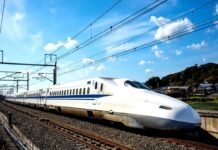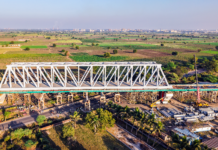Metro Rail News Managing Editor Mr Narendra Shah conducted an email interview with Mr. Vinay Kumar Singh, MD, NCRTC. In which Mr Singh shared his ideas on the growing role of RRTS in the transport sector and threw light on the differences between RRTS and Delhi Metro Rail System. Mr Vinay talked about the upcoming technologies in metros like the Common Data Environment, 3D Models Virtual Reality, Continuous Operating Reference Station (CORS) etc. He discussed that the RRTS are a boon for inter-city connectivity in the NCR region. It will increase the overall productivity of the area by stimulating polycentric development, economic activity etc. Here are the edited excerpts:
Narendra Shah (NS): What major challenges do you see in the transport systems in the National Capital Region?
Mr. Vinay Kumar Singh (VKS): Connectivity options currently available in the National Capital Region (NCR) include time-tabled trains for intercity travel, Delhi Metro Rail, DTC Buses and taxis etc. Given the urban expanse of the region and concentration of economic activity in few central pockets, what is missing is a fast, reliable and comfortable mobility solution for regional commute between urban and sub-urban nodes. This is the gap that the RRTS, a rail-based regional transit system is going to plug in.
Let us take example of Delhi-Meerut connectivity. Existing road connection between Delhi and urban nodes like Sahibabad, Ghaziabad, Modi Nagar enroute to Meerut passes through congested roads prone to vehicle accidents, and any further widening of roads in this corridor will involve huge rehabilitation and resettlement issues. The travel time from Delhi to Meerut city centre to city centre, even with private vehicles is more than 3 hours during peak hour traffic. Also, the existing rail transport has low frequency, lacks reliability and has high travel time. Further, as per published data, the line capacity utilisation of Indian Railways network on this route is more than 100 percent. Hence it is not feasible to increase the frequency of existing services significantly.
Delhi-Ghaziabad-Meerut RRTS corridor will allow commuters to travel from Meerut to Delhi in less than an hour. The requirement of better regional connectivity in the form of RRTS has been long identified as one of the most critical interventions required to achieve balanced and harmonised development of NCR.
In line with the international experience, once operational, a high throughput system like RRTS will unlock economic development potential of the entire region, decongest the capital city, and integrate the NCR in true sense by providing transit connectivity to various urban and sub-urban nodes.
2) In what ways will the Regional Rapid Transit System (RRTS) be different from Delhi Metro Rail system?
Metro train systems have revolutionised the way people travel and have enhanced the adoption of mass public transport systems within the geographical limits of a city. However, as I said earlier, RRTS will provide fast, safe, and comfortable mode of intercity commute in NCR.
While implementing the RRTS, NCRTC is building a huge network of networks in the region. Several RRTS stations have been strategically planned so as to enable seamless integration with other modes of transport like metro stations, railway stations, inter-state bus terminals (ISBT), bus stands/ depots, etc. This will help people to travel seamlessly from one point to another and save significantly on travel-time.
If we talk of the difference from Metro systems, RRTS trainsets will have a design speed of 180 Kmph, and a resultant average speed of about 100 km per hour, which is three times faster than the current resultant average speed of Metro trains of 30-35 km per hour.
Further, RRTS trainsets, which are being designed and manufactured in the country, will provide features like comfortable 2×2 transverse seats, overhead luggage racks, USB/ electric charging for mobile/ laptops, onboard Wi-fi for infotainment, and one premium class coach in each train. Another important intervention that we have done is to enable the RRTS infrastructure, be it stations or trains, to carry patients on stretcher/ wheelchair in case of rare medical emergencies. I believe this facility will prove to be a life saviour for people on the corridor by providing them access to the most advanced medical facilities of the country.
3) This was about the passenger experience, further, what are the differences in the underlying technologies that make RRTS first-of-its-kind in India?
True, owing to the high design speed of 180 kmph, every sub-system of the RRTS has application of technology at a different level from its previous applications in India. Moreover, as a strategy we have adopted state-of-the-art, future looking technologies across these sub-systems therefore making it a first-of-its-kind implementation in India.
For example, even in case of underground civil structures, tunnel diameter will be higher owing to provision of luggage racks in the coaches and higher speed. Also, the viaduct girders are heavier and stiffer to support low tolerance track.
For low maintenance ballastless tracks for high speed, Austrian pre-cast track technology, which is considered one of the best available track systems globally, is being installed for the first time in the country.
If we talk of traction, Rigid Overhead Catenary System for design speed of 180 kmph is being installed for the first time in India.
We are implementing European Train Control System Level 2 (ETCS L2) signalling in RRTS, one of the most advanced signalling & train control system in the world. This will be for the first time in the world that combination of the latest ETCS Standard, the latest Digital Interlocking and Automatic Train Operation (ATO) over Long-Term Evolution (LTE) radio will be deployed. ETCS Level 2 system will allow interoperability among different RRTS corridors.
Further, modern system-operated, Made-in-India rolling stock with high acceleration/ deceleration shall be used for RRTS which shall be different from Metro systems.
Last but not the least, for the first time in India, Metro services in Meerut, shall be operated on the same infrastructure of RRTS which is a different service altogether adding to the technological complexity.
4) Can you highlight any major innovations or advanced technologies being deployed in the RRTS implementation?
Certainly, making RRTS a technologically advanced system has been one of the core strategies since beginning. I have always encouraged my team to adopt best-in-class technological solutions for not only enhancing passenger experience but also in the implementation of the project.
We are using innovative IT enabled tools and modules, developed in-house for various aspects of project implementation. The tool for project monitoring and management, called SPEED, developed by our own IT team has been refined iteratively with our own implementation experience and has become so effective that NCRTC is even supporting other public transit organisations to implement this tool for their project management.
In addition to SPEED, we are using many other technological solutions, which are helping us make implementation more effective and efficient. These include Common Data Environment (CDE) which helps teams collaborate and exchange documents on one platform with clearly defined workflows and Building Information Modelling (BIM) which is a virtual reality-based technology that provides a digital representation of the physical and functional characteristics of the RRTS project. BIM uses CDE to share intelligent 3D model and enables document management, coordination, & simulation on a real-time basis, forming a reliable foundation for decisions during the project lifecycle. With 3D models Virtual Reality (VR) views, everyone in the team knows from day one that what kind of structure they are going to construct, making the collaboration between designers and engineers in the field seamless and smooth. This helps us in saving time in resolving conflicts and reducing capex.
Another innovative technology that we implemented successfully, is use of Continuous Operating Reference Station (CORS) network with multiple Global Navigation Satellite System (GNSS) base stations which are located at stable locations and these stations operate 24 X 7 at a distance of 5 to 10 km along the corridor. This is an advanced technique which eliminates distance dependence, ionospheric and manual errors in surveys and enables availability of accurate reference points for installation of track-system, etc.
5) You have also served as CEO, HSRCL; Group General Manager, Rail Vikas Nigam Limited; Multiple and Key Positions in Indian Railways. How would you use your experience of working in these important portfolios for development of RRTS for NCR?
During my career spanning more than three decades, I consider myself fortunate to have worked in positions where in I could gather good understanding of advanced technologies in the railway sector in addition to enhancing my management knowhow.
In my current role, I have been given to spearhead the RRTS project which is probably technologically most advanced implementation being undertaken in the rail-based infrastructure sector in the country. My past experience of developing the foundation of high-speed project in India has proved quite beneficial. For developing the right knack of leading project implementation, I give credit to my initial stints at Indian Railways and Delhi Metro.
Also, acknowledging how I have learnt throughout my career, I encourage employees across the board to keep learning new technologies and systems, provide opportunities to them for upskilling, remain open to new ideas and initiatives, and challenge the ‘status quo’. Further, in this organisation, I have tried to build a culture which prioritises a commuter-first approach in all our plans, strategies, and actions.
I believe focus on selection and upskilling of a committed and passionate team can do wonders and we are working together to prove this with a timely and successful implementation of RRTS.
6) Do you think RRTS alone can be an ideal solution for mobility needs of a rapidly increasing urban population in India?
Well, certainly RRTS can pave the way as a transformative mobility solution that can play key role in providing sustainable solutions to resolve the multiple crises being faced by our urban centres. However, without a close and dynamic integration of transport and land-use planning, the problem can’t be solved in its entirety.
Currently, with Metro System commuters in NCR provide a “one-hour access” in a radius of about 30 Kms from the city centre. Once RRTS is operational, commuters will be able to travel in a radius of about 100 Kms within an hour. This average speed can be further increased to up to 125 Km/hr if we enable our stations for hopping services. Thus, with RRTS coming in, one can easily stay in their hometowns like Meerut, Ghaziabad, Modinagar, Manesar, Panipat and travel to Delhi within an hour, to access education, employment, healthcare and recreational facilities.
RRTS will enhance overall productivity of NCR leading to greater economic activity, encourage polycentric development in the region, and enhance reach to affordable housing. RRTS will entail a significant modal shift of passenger transport from road to rail, help reduce vehicular congestion, air pollution, and permanent migration to Delhi.
With multi-modal-integration as one of the core strategies, RRTS will lead to creation of a huge network-of-networks in the NCR and increase in share of public transport in the region.
RRTS can be replicated to provide high-speed seamless connectivity to other urban agglomerations. If given a mandate, NCRTC will be glad to play a strategic role to support implementation of similar high-speed mobility projects in the country.
7) What is the time frame decided for completion of the first RRTS project of the country? Is there any plan regarding scale up of the project or any major development envisioned for the ongoing project?
NCRTC has been given the mandate to implement eight RRTS corridors connecting the key nodes across NCR, with Delhi-Meerut, Delhi-Panipat, and Delhi- Alwar being the three corridors to be developed in the Phase-1.
The Priority Section of 17 kms between Sahibabad to Duhai will be commissioned by March of 2023. Commissioning of the full corridor from Delhi to Meerut, along with metro services in Meerut, will happen by 2025. While the target is to commission by March of 2023, but the speed at which our teams are working, we are confident that we will deliver it before the schedule.
The progress of the project is attributed to the indomitable spirit of more than 14,000 workers & 1100 engineers working passionately at the RRTS sites, and cooperation of our key stakeholders – Ministry of Housing and Urban Affairs (MoHUA), State Governments of UP, Haryana, Rajasthan, & Govt. of NCT of Delhi.
8) Shall definitely like to know your views about Metro Rail News.
The country has seen successful implementation of metro rail projects across its urban centres. In addition, we will now be having multiple high-speed rail projects. In this scenario, a reputed publication like Metro Rail News, dedicated to the sector, is playing an appreciable role in keeping the key stakeholders & decision-makers connected, and abreast with the latest developments in the industry. The wide variety of topics the editorial team at Metro Rail News picks for every issue and the attention to detail with which they address each new story is quite impressive.






